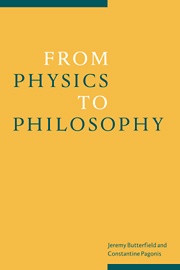Book contents
- Frontmatter
- Contents
- List of contributors
- Preface
- Introduction
- 1 Locality and the Hardy theorem
- 2 Beables in algebraic quantum theory
- 3 Aspects of objectivity in quantum mechanics
- 4 The ‘beables’ of relativistic pilot-wave theory
- 5 Bohmian mechanics and chaos
- 6 Strange positions
- 7 From metaphysics to physics
- 8 Models and mathematics in physics: the role of group theory
- 9 Can the fundamental laws of nature be the results of evolution?
- Bibliography of the writings of Michael Redhead
- Index of names
- Index of subjects
6 - Strange positions
Published online by Cambridge University Press: 23 December 2009
- Frontmatter
- Contents
- List of contributors
- Preface
- Introduction
- 1 Locality and the Hardy theorem
- 2 Beables in algebraic quantum theory
- 3 Aspects of objectivity in quantum mechanics
- 4 The ‘beables’ of relativistic pilot-wave theory
- 5 Bohmian mechanics and chaos
- 6 Strange positions
- 7 From metaphysics to physics
- 8 Models and mathematics in physics: the role of group theory
- 9 Can the fundamental laws of nature be the results of evolution?
- Bibliography of the writings of Michael Redhead
- Index of names
- Index of subjects
Summary
Introduction: localization and Lorentz-invariant Quantum Theory
The current status of localization and related concepts, especially localized statevectors and position operators, within Lorentz-invariant Quantum Theory (LIQT) is ambiguous and controversial. Ever since the early work of Newton & Wigner (1949), and the subsequent extensions of their work, particularly by Hegerfeldt (1974, 1985), it has seemed impossible to identify localized statevectors or position operators in LIQT that were not counterintuitive – strange – in one way or another; the most striking strange property being the superluminal propagation of the localized states.
The ambiguous and controversial status of these concepts arises from the varied reactions that workers have to the strange properties. Some regard them, particularly the superluminal propagation, as utterly unacceptable, and conclude that no precise concepts of localized statevectors and position operators exist in LIQT (Wigner 1973, pp. 325–7; 1983, pp. 310–13; Malament 1996). Others downplay the whole issue, on the grounds that current theoretical and experimental practice has no need of sharply formulated concepts of localization, localized states etc. (Birrell & Davies 1984, pp. 48–59; Haag 1992, p. 34).
Still others, including ourselves, believe that the superluminal propagation does not lead to causal contradictions, and is not in conflict with available empirical data: so that it should not be ruled out. We also believe that the other strange properties are merely unfamiliar novelties of LIQT which we must simply learn to accept. (Like the superluminal propagation, they do not lead to causal contradictions, nor conflict with available data.) So in this essay, we aim to help remove the ambiguous and controversial status of localization concepts in LIQT.
- Type
- Chapter
- Information
- From Physics to Philosophy , pp. 108 - 165Publisher: Cambridge University PressPrint publication year: 1999
- 13
- Cited by



